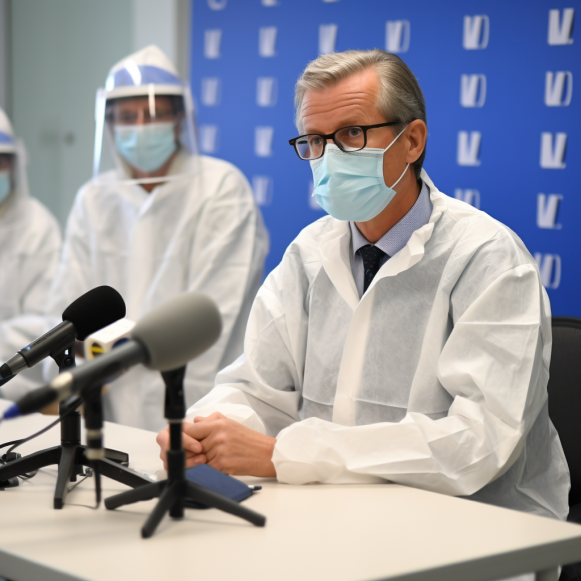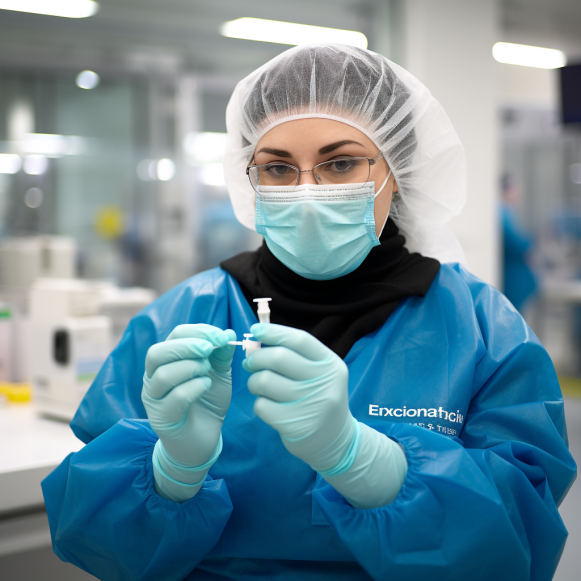An Ongoing Threat: The Dangers of modRNA Vaccines and Boosters

The truth behind RNA-based vaccine technology (Part 2)
Perspectives on Health
The next COVID-19 vaccine campaign is getting under way. Americans are being encouraged to get their vaccinations up to date just in time for another round of booster shots.
Meanwhile, BioNTech, a Pfizer official collaborator, admits that its messenger RNA (mRNA) vaccines contain modified RNA (modRNA), and Moderna recently announced that its updated vaccines will be shipped across the country.
ModRNA vaccines and boosters, also known as RNA-based injections, can endanger the health of anyone who receives them. These injections are dangerous in five ways.
1. Lipid Nanoparticles (LNPs) Can Smuggle modRNA Into Any Cell
During the early stages of the COVID-19 pandemic, lipid nanoparticles (LNPs) were heralded as tiny superheroes capable of delivering mRNA molecules coding for the SARS-CoV-2 spike protein into our cells. They are, however, more akin to Trojan horses that slip past biological barriers and smuggle modRNA into our cells.
LNPs are made of lipids (fats) that have been arranged to form a sphere. LNPs conceal the modRNA from our immune system until the lipid sphere merges with the lipid walls of our cells, at which point the modRNA can enter our cells. LNPs are made up of phospholipids, cholesterol, PEGylated lipids, and cationic lipids. Cationic lipids, which may be cytotoxic, are the most problematic of these. The cationic lipids in the Pfizer-BioNTech and Moderna COVID-19 vaccines cause acute inflammatory responses, according to a 2022 editorial.
Because of their small size (less than 100 nanometers), LNPs can easily cross biological barriers and theoretically reach every cell in our body, including brain and heart cells.
What has been promoted as a safe method of delivering medicine to our cells is actually dangerous and can have long-term consequences.
2. modRNA Forces Healthy Cells to Synthesize a Viral Protein
The synthetic modRNA in COVID-19 injections was created by replacing naturally occurring uridines, which are found in the mRNA of all living organisms, with synthetic methyl-pseudouridines.
This modification makes the RNA more stable (lasts longer before breaking down and can be translated more effectively) and less likely to cause unwanted immune system reactions. ModRNA induces healthy cells to produce a viral protein. As described in the first article of this series, this has enormous negative consequences.
3. Spike Protein Transforms Cells From Friend to Foe
Each cell represents a single component of the entire organism. It’s similar to an orchestra, where each musician has a specific role. If just one musician makes a mistake, the entire orchestra suffers. Similarly, if a cell produces foreign proteins (such as spike protein from viral infection) or unspecific proteins (such as cancer cells), our immune system destroys the cell for the benefit of the entire organism.
As an example, consider spike protein. Spike protein on the cell surface can act as a label, signaling the immune system to start the cell’s destruction. Killer T cells will detect foreign proteins attached to our body’s cells. The complement system, a cascade of enzymes in blood serum, permeabilizes the cell membrane and eventually destroys it.
The goal of a vaccine is to protect us from a virus infection. As a result, each RNA-based vaccine will eventually produce a viral protein that will be recognized by our immune system and result in the production of antibodies.
The fact that all RNA-based (modRNA) injections in the future—boosters and any other RNA-based shot—will force healthy cells to synthesize a foreign protein of a viral pathogen, present it on the cell surface, and initiate an immune response—is a death sentence for that cell.
This will also occur during a natural infection; however, antibodies generated will bind to a virus (preventing infection of new cells and stopping replication) but will not bind to LNPs provided by each new shot and thus cannot stop the continuous production of spike or any other protein produced by our cells.
Concerning COVID-19 “vaccines,” the antigen of interest is the SARS-CoV-2 spike protein, which is toxic on its own.
Non-neutralizing antibodies may be produced in addition to the desired neutralizing antibodies, resulting in antibody-dependent enhancement (ADE), which makes the host’s body more susceptible to illness associated with subsequent infections or booster injections.
4. Synthesized Viral Protein Causes a Hyper-Inflammatory Immune Response
A hyper-inflammatory immune response is triggered by the continuous presence of the synthesized viral protein (or parts of it) in the bloodstream (or the body).
Unlike a natural infection, which is unlikely to stay in our system for months, booster shots keep our immune system constantly active, leading to hyper-inflammation (as shown in the figures below).
According to Harvard Women’s Health Watch, a “chronic state of inflammation can lead to numerous health problems, including heart disease, arthritis, depression, Alzheimer’s disease, and even cancer.”
A recent study compared the immune response in viral infection and traditional protein-based vaccination to repeated boosters of RNA-based injections (shown in the figure below).

Left: In the case of a viral infection or a traditional protein-based vaccination, the immune system is activated from the moment the virus is encountered. However, it will take some time for our immune system to produce the appropriate antibody capable of binding and neutralizing the virus, as well as enough of this antibody to prevent the virus from entering new cells and thus from replicating further. It’s worth noting that the immune response (blue-shaded area) increases even after the viral load (red-shaded area) decreases, limiting the severity of the inflammation. In the case of secondary contact with the virus, a similar scenario occurs; however, the immune memory response (blue line) prevents virus replication early on and keeps the viral load (red line) at a much lower level.
Right: For repeated RNA-based boosters (with pre-existing immunity), any modRNA vaccine will deliver the entire amount of modRNA in seconds, followed by spike protein production in a few hours. As a result, an elevated spike protein and a strong immune response occur at the same time, resulting in hyperinflammation.
In summary, modRNA injections keep the body in “fight” mode, never allowing it to return to normal balance. The constant battle wears down the body, resulting in serious health consequences or even death.
According to two studies, continuous exposure to the same antigen causes a decrease in immunoglobulin (IgG1) antibodies (which fight the antigen) and an increase in IgG4 antibodies (which ignore the antigen). The consequences are unknown, but increasing the IgG4 subclass is thought to increase viral persistence and explain breakthrough infections in people who have received multiple COVID-19 injections. This happens after the third injection (the first booster).
5. modRNA Could Merge With Our Genome
If a viral gene sequence integrates into a host’s genome, it can have serious consequences for the cell. This integration can disrupt the cell’s normal metabolic functions or, in more severe cases, turn a previously healthy cell cancerous.
Consider it like a computer virus inserting malicious code into a program; the program suddenly begins behaving erratically and may even crash completely.
Alternatively, once a viral sequence has been incorporated into our DNA, it may go dormant and cause no immediate harm. It’s like a sleeping dragon, peaceful for the time being but likely to awaken later, especially during stressful times.
In an unexpected twist, the integrated viral sequence does not simply disappear. When the viral sequence embeds itself in a host’s sperm or egg cell (oocyte), it has the potential to be passed down to our children in the same way that an unexpected family heirloom is written into our very DNA.
The Centers for Disease Control and Prevention (CDC) in the United States continues to state unequivocally that “COVID-19 vaccines do not change or interact with your DNA in any way,” writing on its blog that “Vaccine mRNA is non-infectious and is broken down quickly in the body.” It does not become a part of the cell or affect the genes or DNA of a person.”
This, however, has been proven incorrect.
First, in 2022, a study using human liver cells (specifically, a cell line called Huh7) discovered something significant about the Pfizer-BioNTech COVID-19 vaccine known as BNT162b2. Researchers discovered that the modRNA from this vaccine could be converted back into DNA in as little as six hours, a process known as reverse transcription.
Second, the debate over whether “vaccine-RNA” can be converted back into DNA took an unexpected turn. A recent study found contaminating DNA in up to 35% of the nucleic acids in both the Pfizer-BioNTech and Moderna COVID-19 RNA-based vaccines.
Contaminating bacterial plasmid DNA left over from the manufacturing process could result in multiresistant germs, as plasmids contain antibiotic resistance-encoding sequences. This plasmid DNA sequence matches the modRNA sequence, which encodes the spike protein. DNA is more stable than RNA, which increases the likelihood that it will enter our cell nucleus (where it is naturally found) and integrate into our genome. As a result, some of the spike protein found in our bodies may be derived from that contaminating DNA.
According to the European Medicines Agency (EMA) assessment report (pdf) on Pfizer-BioNTech’s COVID-19 vaccine, “no genotoxicity studies have been provided.” This is acceptable because the vaccine formulation contains lipids and RNA that are not expected to be genotoxic.”
This is extremely surprising, as modRNA injections can be expected to cause genotoxic effects via the following pathways after cellular uptake:
- Cationic lipids, which are a component of LNPs, are known to cause the formation of reactive oxygen species (ROS), which are harmful to DNA integrity.
- ModRNA, the active ingredient in the “vaccine,” can be reverse-transcribed into DNA and inserted into our genome.
- Contaminating DNA in RNA vaccines has the potential to be inserted into our genome. This is the norm rather than the exception, as there is no reliable method for separating mass-produced RNA (of any kind) from plasmid DNA.
Government “vaccination programs” that force healthy people all over the world to undergo an unproven gene therapy treatment must be halted immediately, because any new technology applied to healthy people requires a valid benefit-risk analysis through long-term surveillance in preclinical and clinical trials.





